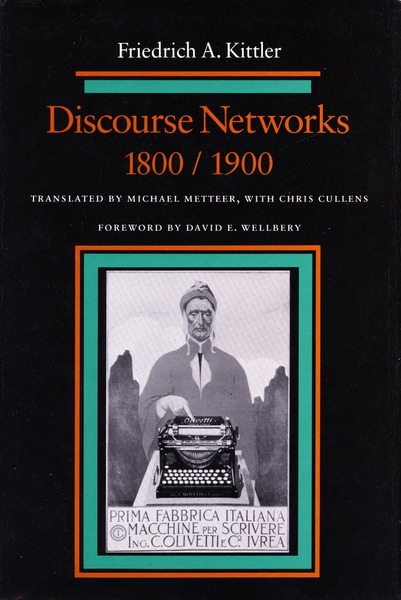Friedrich A. Kittler (1943- 2011), a literary scholar and a media theorist whose work provide huge research value especially in the media archaeology territory. Parikka defined Kittler as a pioneer researcher in the former argument of media archaeology, the New Film History territory — a theory that suggested “investigating the subject (the spectator, the viewer, the user, the gamer) of media culture in historical ways.” (Parikka, 2014, p19) Meanwhile, this approach also feeds into an understanding of the historical and complex forms of sensation.

Wellbery defined Kittler’s critical analyzing approach in the foreword as “a reasonably recognizable contrasting image” is that “ he has nowhere to employ the notion of ideology.” (Wellbery, 1990, p.xvii) I would like to argue the phrase of ‘nowhere’ here since in my personal perspective; Kittler relied heavily on media archaeology approach to develop his literal thinking. Thus, one of Kittler’s valuable works, Discourse Networks 1800 / 1900 provides an interesting example. Since the two major part: ‘discourse network’ 1800 and 1900 are systematically comparable, more significantly, the comparison could present the uniqueness of media archaeology approach intuitively.

Kittler was influenced by structuralism in the first place, since the core idea of structuralism is the binary opposition which developed fast during the period between 1800 and 1900. While after that, he reconstructed romanticism from the perspective of media technology, since his major analytical material is a rather famous and historical text — Faust by Goethe. Faust is a representative meta-text of the 19th century since it published at the beginning of the 1800 and this text itself prefigures everything about the discourse network.
On the other hand, the second half of Kittler’s work which is mainly towards the discussion of ‘the discourse network 1900’, shows a strong tendency towards modernism. Since the 1900 section argues that within the new discourse network, literature that situated in the modern period is characterized by new technological media such as film or photography. “A film trick demonstrates what happens to people when the new medium takes hold of them.” (Kittler, 1990, p244) Kittler believes that a film does not need “a solitary hero of a romantic novel” to raise the audience’s identification. (Kittler, p245) Indeed, what Kittler pointed out, is exactly the radical influence of film, not only wordless but also ‘automatically’ involved audience into this medium.
After all, the core rupture between 1800 and 1900 is the rupture of linguistic view. The linguistic view of 1800 or romanticism is the logic of reference, while the linguistic view of 1900 is the logic of signification. Kittler’s discussion, which shown consideration to both 1800 and 1900 turns out to be ta enormous treasure of film studying. As a film practitioner born in the late 1990s, I would say that Kittler owned the unique perspective towards media archaeology that only researchers born in that period could directly observe and perceive.
Written by: Xue song
References:
Kittler, A, F. (1990). Discourse networks 1800/1900. Stanford, Calif. : Stanford University Press. [Online] Accessed: 26th/ July/ 2020. Available from: https://books.google.co.uk/books/about/Discourse_Networks_1800_1900.html?id=nRo0Pk8djjoC&redir_esc=y
Parikka, J. (2012). What is media archaeology?. Polity Press. p19 [Online] Accessed: 24th/ July/ 2020. Retrieved from https://ebookcentral.proquest.com
Wellbery, E, D (1990) Discourse networks 1800/1900. Stanford, Calif. : Stanford University Press. [Online] Accessed: 26th/ July/ 2020. Available from: https://books.google.co.uk/books/about/Discourse_Networks_1800_1900.html?id=nRo0Pk8djjoC&redir_esc=y